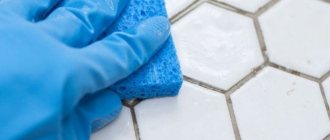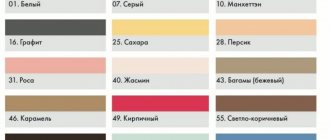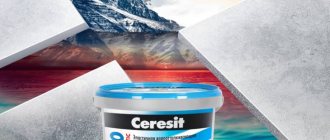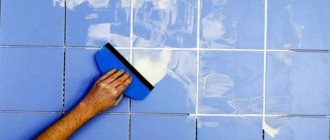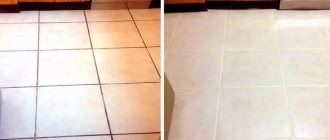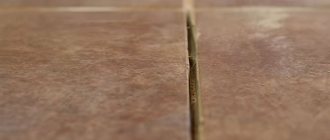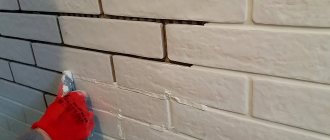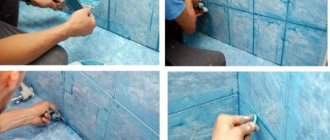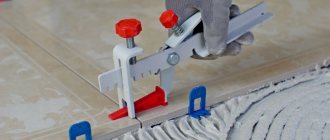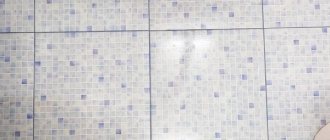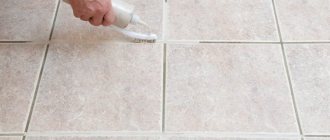Now you can proceed to the final stage - grouting the joints and treating them with sealant. A well-made grout can mask existing installation defects, while a poorly done grout can completely destroy the impression of a flawless installation.
First check that the adhesive on which you laid the tiles is completely dry and thoroughly clean the seams from debris and dirt. Remove any spacers (crosses) left between the tiles after installation. Some manufacturers of dividers state that they can be left in the seams and covered with grout. But in this case, the layer of grout above the dividers will be thinner, so it will have a different color after it hardens and can ruin the appearance of the entire grout.
If you are working with glazed tiles, you can immediately start grouting the joints. If you are laying unglazed tiles, you should first dampen the top and sides of each tile to prevent too much moisture from being sucked out of the grout. Some tile installers use garden sprinklers to spray water over the surface of the tiles.
Regardless of which method you choose, the main thing is not to overdo it. Puddles of water left on the tiles or in the grout can damage the grout, which can then crack. (To avoid doubts about carrying out such preparation of tiles and joints, it is better to consult with the grout manufacturer).
Types of grouting materials
There are 2 main types of grout: cement-based grout and epoxy-based grout.
Advice: when choosing, do not confuse grouting materials with elastomer sealing compounds that are used in construction - they fill the joints of various building materials. Such seals include silicone seals.
The store will tell you that it is actually used for tiles, and they will be right. Just don’t use silicone sealant to fill the seams between the tiles. It is designed to fill voids when laying tiles on another surface. It is sometimes used to fill joints, but it is best to avoid this.
Cement-based grouts are a dry mixture that is diluted with water or liquid latex. Ready-made grouts are also sold, but they usually cost much more. Cement-based grouts are usually made from cement and differ only depending on the additives that are included in their composition. All of them can be divided into 3 classes: industrial cement, dry hardener and latex mixture.
Epoxy grout contains epoxy resin and hardener, which make the joints impact-resistant and resistant to various chemicals. This type of grout is the most expensive, and therefore is mainly used in industrial and commercial premises. In addition, epoxy grout is viscous and quite difficult to work with. If your tiles are no more than 12 mm thick and the joints are less than 6 mm wide, then such grout will not be able to penetrate such narrow joints.
Tool
To do the job you will need an inexpensive but specific tool:
- A bucket in which the solution will be mixed.
- Drill with mixer attachment (needed for large batches).
- Rubber grater.
- Putty knife.
- Narrow rubber spatula.
- Foam sponge.
- Soft cloth.
Depending on the fugue chosen, you may need a special tool designed for its application.
Color selection
When choosing a grout color, rely not only on quality, but also on your aesthetic preferences and tastes. It is best to choose colored grout from the same store where you buy the tiles. Since the “random” buying method does not always meet your expectations of the final result.
Having looked at all possible combinations of finishing options, you can (and even need to) visually transfer this to your surface. It should be remembered that various color combinations affect the perception of the entire pattern. For example, light grout on a dark background (or vice versa) creates more geometrically contrasting patterns in your composition.
This approach emphasizes the merits of each tile. By the way, playing with contrast goes well with mosaics and small tiles. But if you decide to purchase a mosaic panel or photo tile, it is recommended to select a color that matches the cladding.
You can also achieve the color you want by adding dyes to the original white or colored grout yourself. It's difficult, but possible. But here, of course, you can’t do without a bit of luck and risk. As a result, the color may not be very bright, sometimes even unpredictable and less resistant to fading.
If it is difficult for you to choose or make a suitable color, then you will not go wrong by choosing white grout. This is a classic option. Almost perfect for most ceramic tiles. In damp rooms it must be moisture resistant. Additionally, the seams can be treated with a special protective agent to prevent darkening.
But for floors, white may be too easily soiled. And after a short period of time it will look dirty. Here you can get by with gray grout, similar in color to cement.
Useful tips
When grouting joints on tiles that have a textured surface rather than a smooth one, the mixture from the front surface of the tile must be immediately washed off with copious amounts of water. Otherwise, it will be extremely difficult to bring it into decent shape. When hardening, grout that has become embedded in small depressions in the relief is very difficult to clean. You could ruin your whole job.
If the tiles “do not fit,” then the seams are of different widths along one row - vertical or horizontal. In this case, after filling the seams as standard, you can use this trick: stick masking tape on both sides to a dry and clean tile along the entire length of the seam that needs to be corrected. The width of the seam is chosen based on the widest one. The grout is diluted a little more liquid than for filling joints.
Carefully apply the mixture to the seam being formed, immediately smoothing it out and eliminating defects. The tape is removed without waiting for the mixture to harden. Otherwise, along the edges, the grout will begin to crumble and the edge of the seam will become jagged instead of straight. Masking tape can also be used when grouting tiles with small relief to protect the edge of the front surface from getting the grout mixture on it. In this case, you won’t have to spend a lot of time washing. The same applies to finishing materials with a porous structure. You simply can’t do without adhesive tape here.
After grouting all the vertical and horizontal seams, do not forget to fill with the mixture all the technological cutouts on the tiles near the heated towel rail, outlets for hot and cold water, taps for connecting the washing machine, and so on.
When filling joints on tiles with straight (unsmoothed) ends, the joints must be made without recess. That is, the seam and the front surface of the tile must form a single surface. Otherwise, the brown side surface will be visible from under the grout and ruin the whole impression.
To grout tiles, you can buy a mixture that matches the color of the tiles. But sometimes manufacturers use such colors and designs that it is simply impossible to buy a ready-made mixture of colors. In such cases, you need to buy either just white grout, or the closest color, and bring it to the desired shade by adding tinting paste of the required color range.
If laid perfectly and well-calibrated, tiles can be grouted exactly to the color of the finishing material used to achieve the effect of a seamless surface. If the tiles are not of the best quality, are bent (very common on tiles with one side measuring more than 40 cm), and the installation is not done perfectly, it is better to use grout of a contrasting color. This way you can “hide” minor differences between adjacent tiles if you were unable to “press one of them into the plane” and it “jumped out”.
If you use ready-made grout, be sure to first “collect” the composition that is “spread” on the walls of the bucket. Otherwise, this mixture will dry out very quickly, particles of the dry solution will fall into the finished composition and then stick out in fragments in the formed seam.
They will have to be removed from the already finished seams and double work will be done, covering up the resulting defects.
When assessing the quality of the grout after it has dried, small defects may be discovered in the form of uneven seams. They can be removed using fine-grained abrasive materials, or, more simply put, sanded. This must be done before the grout turns to stone. You can also go over such defects manually with grout diluted to the state of liquid kefir. Be sure to ensure that the resulting seam is smooth, without transitions.
The grout on the floor is not light in color. Over time, after numerous floor washings and exposure to dust and dirt, it will darken and lose its appearance. Therefore, for floor tiles, either buy a ready-made mixture of a darker color, or tint it yourself to the desired shade.
The grout in the seams, especially if they are wide, remains soft and flexible much longer than on the tile surface. After working on the floor, it is better to carry out any operations three to four hours after filling the seam with it. Otherwise, you can push through it and have to start all over again.
When using a cement-based mixture, sometimes difficulties arise in removing its residues from the front surface of ceramic tiles. Nowadays, construction stores sell special solutions for flushing out cement mortars, usually in the form of bottles with a spray trigger. You can use them to simplify your work.
If the selected product does not have water-repellent or antifungal properties, you can buy these products separately. They are sold in liquid form in small bottles. The treatment is carried out with a small brush, thoroughly washing or wiping the tiles after this procedure, without waiting for the composition to dry.
What is sealant used for?
The use of sealant serves 2 purposes:
- it protects ceramic tiles from stains appearing on them and in the joints
- it protects the tiles and grouts to a certain extent from excessive water absorption
To prevent stains from appearing on the surface of unglazed tiles and on the seams, it is necessary to cover the cladding with a liquid transparent sealant. Most sealants are made from silicone, varnish or acrylic. When choosing the right sealant, you need to consider the types of tile and grout, as well as the location where the tiling is being done.
Now let's learn how to grout joints, apply grout and sealant. In addition, always follow the directions of the manufacturer of the product you choose.
Planned time costs: Depends on the size of the area; It takes about 3 weeks until the grout dries completely. Planned cost of funds: 30-50 dollars. Initial tips: Consult with the seller regarding the selection of the most suitable grout. Safety Tips: Cement-based grout can cause inflammation of the eyes, skin and lungs. When working with them, use a respirator, safety glasses and rubber gloves.
Care instructions
After finishing work, the material must dry completely. As a result, it becomes moisture resistant, which allows you to regularly maintain the coating: clean the surface with a damp cloth, wash the floor.
It must be remembered that cement is less resistant to constant exposure to water.
For this reason, it is recommended to care for the coating, the seams of which are filled with cement-based grout, using a damp cloth.
How to prevent cracking?
To avoid such troubles, it is necessary to mix the material correctly. Use the exact amount of components specified in the manufacturer's instructions. In this case, the finished solution should be characterized by a uniform consistency, without fractions. While preparing the grout, take a break for 5-6 minutes, then continue stirring it.
After finishing the work, while the mixture dries in the space between the tiles, the room should not be ventilated. It is also not recommended to use hot water, as this produces steam, which can negatively affect the properties of the material.
Width of grout joints
The width of the grout joint is partly a matter of personal preference; some people like narrow joints, for example. Too wide seams seem to visually suppress the tiles. Square tiles measuring 10, 15, 20, 25, 30 and even 60 cm will look neat with 3 mm joints. Irregular tile shapes are less noticeable with wider joints, but try to keep them no more than 12mm wide. The fact is that the wider the seam, the more likely it is to crack.
A joint with a width of more than 12 mm will be more durable if sand with a large particle size is added to the grout, but this does not always help protect a wide joint from cracking. (Another reason why grout can crack and crumble is if there is too much liquid when mixing the grout).
Equally, you should not make the grout joints very narrow, because it will be difficult to fill them with grout properly, and as a result, water will seep through such joints into the cladding. Many craftsmen feel more confident that the quality of the cladding will be at the proper level if the seams are wide enough to be filled with latex or acrylic grout, as a result of which the seams will not only become waterproof, but can also serve as shock absorbers during compression and expansion of tiles. This ability of seams becomes negligible when the seam width is less than 1 mm.
Grouting tiles
The grouting process includes several stages:
- Mixing grout
- Keeping the solution for better wetting
- Re-mixing the grout
- Solution distribution
- Cleaning up excess grout
Tools and materials needed to apply grout:
- Respirator (for working with grout containing cement)
- Latex gloves
- Protective glasses
- Rubber scraper or roller
- Grout
- Bucket
- Sponge
- A jointer, a wooden stick with a sharpened end, or a toothbrush
- Clean cloth
- Plywood
- Sealant
- Paint roller or small paint brush
Applying grout
First, spread a mound of grout onto the surface of the tiles (you can simply pour the grout out of a bucket if you are working on the floor, or scoop the grout with a square trowel for applying it to the walls).
In order to distribute the grout, a grout float (in the appropriate version for floors or walls) is more suitable than a steel trowel.
Hold it at a 30-degree angle to the tile (as shown in the photo) and apply grout diagonally to the surface of the tile (as shown in the photo). Run the float over the entire surface two or three times, but don’t just cover the seams with grout, but try to rub it in, press it firmly into the seam so that it is tightly filled with grout.
The stronger the resistance, the more densely the seam is filled and the stronger it will be. The main idea is to fill all the corners and voids around the tiles that remain after applying the adhesive to the top with grout. During the grouting process, the liquid will leave the grout, and the seams will be filled with particles of sand and cement - one might say, you will get a solid body instead of liquid cement paste.
Do not grout the entire surface at once; it is better to first distribute the grout over a small area of about one or two square meters. meters until you figure out how quickly the grout sets. So, if you find yourself working with grout that sets quickly, you will need to stop and clean up.
Sometimes it is possible to immediately wipe about 9 square meters. meters before you start cleaning it; in other cases, only a small area can be covered with grout. Working in a small area will help you determine the speed at which you should work.
Using a grout bag
If you are working on a surface that is particularly difficult to clean after grouting, such as antique brick veneer, use a grout bag to fill the grout. This bag looks and acts just like a piping bag for decorating cakes. A metal tip approximately the same width as the grout joint is attached to the end of the bag. The bag is filled with grout, and then it is squeezed out with force through the tip into the seam.
When working with a grout bag, place the tip of the bag at the top of the joint and slide it forward along the edge of the joint as you fill it. For best results, grout the entire length of the grout rather than around individual tiles. Usually, all horizontal seams (along the x-axis) are filled first, and then the vertical ones (along the y-axis).
You should squeeze out a little more grout than seems necessary. After it has set slightly, tamp the grout into the joint using a jointer or a piece of smooth metal tube, the diameter of which is larger than the width of the joints being filled. Then let the grout pressed into the joint set for half an hour, after which remove the excess with a stiff brush.
How to properly rub seams?
- The first step is to make sure that the glue is completely dry.
- Next, remove any remaining glue, dirt and dust from the seams, as well as the remaining spacers.
- If you used unglazed tiles for laying, then moisten them with water before grouting. Otherwise, it will absorb water from the grout mixture. There is no need to carry out this operation with glazed tiles.
- Before use, the grouting materials must lie for some time in the room where the joint work is planned.
- The best results during grouting can be achieved if this stage of installation is carried out at a temperature between 18–25°C.
Removing grout
The first removal of excess grout is dry.
When all the joints are filled, to remove excess grout you will need a float, which should be held at almost right angles to the surface of the tiles (as shown in the picture). In this case, it is necessary to move the trowel diagonally relative to the seams, otherwise the edge of the tool may get into the seam and remove part of the grout from it (if this happens, just add a little grout to the seam and level the surface of the seam with the edge of the trowel). Once the excess has been removed, allow the grout to set before cleaning. While you're grouting and cleaning, you'll want to remember to stir the grout in the bucket occasionally to keep it soft before applying it to new areas.
The second grout removal is wet. When should I start? After dry cleaning with the edge of a float (which removes the bulk of excess grout from the surface of the tiles), each cladding requires wet cleaning to one degree or another. The time it takes for grout to fully set before wet cleaning varies greatly from installation to installation.
It may be 5 minutes, or it may take 20 minutes or more. The rate of evaporation of liquid from grout is affected by weather conditions, the type of base, adhesive and tiles.
Keep in mind that grout residue on the tile surface may set fairly quickly, although grout may take longer to set in the joints. You can use a sponge to assess the readiness of the surface of the tiles and grout joints for cleaning: wet the sponge as much as possible, and then test a small area of the tile surface. The grout in the seams should be elastic and dense, but not hard.
If the grout sets too tightly, the tiles will have to be difficult to clean, which can damage the seams. On the other hand, if the grout is pulled from the joints behind the sponge, this means that the grout has not set sufficiently. Wait a few minutes and check again. Cleaning can begin when the grout in the joints remains in place.
If it turns out that too much time has passed before you start cleaning, and the grout has dried to the surface of the tile, you can remove it using a special abrasive float. (Unlike other scouring floats, this float does not leave scratches on the surface of the tiles - to be sure, test on a piece of tile first). After cleaning the dried grout residue, go over the entire surface with a well-wrung out sponge.
There are many tricks for cleaning grout, some of them quite unusual. For example, some tilers pour dry grout over the joints (so that the wet grout in the joints dries faster). Others use sawdust so that it will draw out excess moisture so that excess grout can be easily removed. Many of these methods weaken and thereby destroy grout joints, so we do not recommend their use.
It is better to use a combination of proven techniques that is suitable for both commercial and residential cladding. The main principle of this method is to use a minimum of water during cleaning so as not to weaken the grout.
Manufacturers
As always, deciding which grout to use is only half the battle. Choosing a manufacturer is also very important. In general, we can say that the manufacturers are the same as those that produce tile adhesive. Usually there is a whole line for laying and grouting tiles. If you are satisfied with the quality of the tile adhesive, you can also look at the grouting composition from the same company.
These are the color options for polymer grout for tiles
For example, companies Mapei (Mapey), Litokol (Litokol), Ceresit (Ceresit). Among Russian ones, Atlas has normal reviews. As a rule, any of these companies have polymer and cement grouting compounds. And not one at a time, but for different conditions. There are showers with increased water resistance and frost resistance. If we are talking about polymer ones, then they have the ability to add glitter (sparkles).
Start of wet cleaning
All you need is a bucket of clean water and a sponge (it is better to use a sponge with rounded edges, this will prevent grooves from forming in the grout joints).
First, use a sponge to quickly remove most of the excess grout. Begin cleaning the grout from the surface of the tiles using a gentle, circular wiping motion to remove sand and cement particles.
Be careful not to create grooves in the grout joints. Rinse the sponge as soon as the pores of the sponge are filled with particles of cement and sand, and then wring it out well. If not too much time has passed before you start cleaning, you can remove excess grout from the surface of the tiles in two or three passes.
Clean only a small area at a time (1-2 square meters in size), wetting the sponge frequently to wash away any grout particles that have penetrated the pores of the tiles. When you rinse the sponge, always try to rinse as well as possible and squeeze as hard as possible to ensure that any grout particles that were in the pores of the tile are washed away. Be sure to shake off excess water from your hands.
If the cladding is no larger than 9 square meters. meters, there is no need to change the rinsing water in the bucket. You can judge by the purity of the water how well the tiles have been washed (of course, some commercial projects require constant water changes).
At the second stage, you need to inspect the grout joints to see if they are all neat. Level and smooth the seams using a jointer, a wooden stick with a sharpened end, or the end of a toothbrush. Then smooth the edges of the seams with a sponge. Move the sponge parallel to the seam, carefully removing any ridges and filling any gaps with a small amount of grout using your fingertip (wear tight rubber gloves to do this).
The actual joint size depends on the type of tile used and the industrial or artisanal finish of the top edge of the tile. If the edges of the tile are sharp and straight, the grout in the joints should be flat, flush with the top edge of the tile. If the top edge of the tile is rounded, the tiler must decide how high the joint should be.
Whatever height is chosen, ideally the seam should be smooth on top, not convex, although most of the seams then become slightly concave, which is quite acceptable. It is very important to give all seams the same shape and depth.
At the end, a final thorough cleaning of the surface of the tiles from grout residues is done. As soon as the seams in the cladding are leveled, the surface of the tiles should be thoroughly cleaned again. First, rinse and wring out the sponge well. Then make a straight, vertical pass about a meter long with one side of the sponge, moving it slowly towards you - slower than seems necessary - and without stopping (if you move the sponge quickly or intermittently, you will leave grout streaks on the surface of the tiles).
After the first pass, turn the sponge over to the clean side and make a similar pass parallel to the first, then stop and rinse the sponge. For one pass, use the freshly washed side of the sponge. Continue this process until the entire area of the cladding is completely cleaned, trying to act carefully so that again the sponge does not pull the grout out of the joints.
If this happens, it may mean that there is too much grout in the seams and the seams need to be trimmed, or there is too much water in the sponge. After such cleaning, all grout residues must be removed from the surface of the tiles, and the joints must be allowed to dry for 15 minutes.
During this pause, the moisture remaining on the tiles after cleaning evaporates and the cement particles that were in the water are deposited on the surface of the tiles. If the tiles are covered with a shiny glaze, and the corners are smooth and straight, then grout deposits can be easily removed by immediately wiping the surface with gauze or a soft, clean cloth. If the tiles have a matte surface or rounded corners, you may need another, additional pass with fresh water and a sponge.
If the grout residue is still difficult to clean, you may not have cleaned the surface well enough the first time. If there is glue left on the surface of the tile, the latex or acrylic additives contained in it may be the reason why the grout has set more than usual.
However, whatever the reason, the longer the plaque remains on the tiles, the more difficult it is to remove. If you were unable to remove the residue using a damp abrasive float, you can try using a special solution to remove plaque, or, as a last resort, resort to acid cleaners.
If you decide to use special cleaners or acids, keep in mind that the grout needs to fully set before you use them. However, don't wait for the grout to fully set until the final cleaning step is completed - removing any traces of grout from the expansion joints.
Cleaning the tile surface
The tiles will take on a finished look after removing traces of putty. Since the mastic sags when it dries, grouting is done in several steps, and the floor surface is cleaned at the final stage.
Take a foam sponge, moisten it in water and lightly rinse the tile so that the mixture that has dried on it gets a little wet. Then, using a scraper or spatula, holding them perpendicular to the tile, remove the remaining composition from its surface. Stains are removed with a damp cloth or sponge; using them you can correct the work.
The joints should not be made convex or extend into the tiles. To clean grooved tiles, use a toothbrush dipped in water. The putty should be removed before it is completely dry - otherwise it will be quite difficult to soften the grout. As a result, the cleaning process will become longer and more complex.
Peeling off the dried mixture can damage the surface of the tile, especially on glossy products. It is almost impossible to remove hard grout from embossed tiles. Shiny tiles can be treated with window cleaner and then polished.
Applying sealant
Once the grout has hardened, the tiles and joints can be sealed with sealant according to the manufacturer's instructions. Clean the tiles and grout thoroughly and let them dry for a few days. Then apply the sealant following the manufacturer's directions. If you will be sealing both tile and grout, use a paint roller.
If you will only be applying sealant to the seams, use a small brush. Remove any excess sealant that may accidentally end up on the tile surface immediately.
Maintaining your tiles with care sometimes requires that you seal the tiles with sealant every 2 years (sometimes more often if manufacturers require it). Anyway, if you notice. If the tiles become dirty more often and become more difficult to clean, then it is time to cover them with an additional layer of sealant, after thoroughly cleaning them.
Preparation of dry mixture
If you purchased a ready-made composition, you can start working, but if you chose dry material, the main thing is to follow the manufacturer’s instructions. Basically the rules are the same.
- Pour the required amount of powder into the prepared container, add cold water or hardener, add dye if necessary, mix the composition with a mixer.
- The solution should be homogeneous, similar to thick homemade sour cream. After preparing the cement mortar, it is necessary to stand for at least 10 minutes, but in the meantime it is advisable to start preparing the surface.
The hardening time of grouting materials was written above. It is preferable to prepare the grouting material in small parts.
